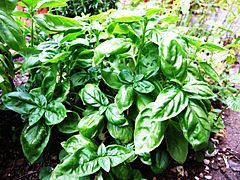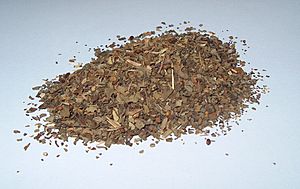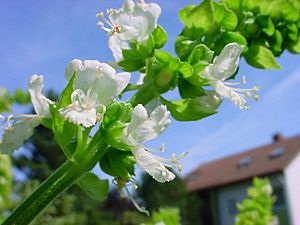Basil facts for kids
Quick facts for kids Basil |
|
|---|---|
 |
|
| Scientific classification | |
| Kingdom: | |
| Division: | |
| Class: | |
| Order: | |
| Family: | |
| Genus: | |
| Species: |
O. basilicum
|
| Binomial name | |
| Ocimum basilicum |
|
Basil (scientific name: Ocimum basilicum) is a popular plant from the Lamiaceae family. You might also know it as Sweet Basil or Tulsi. It's a soft, low-growing herb that can live for many years in warm, tropical places. Basil first came from India and other warm parts of Asia. People have been growing it there for over 5,000 years!
Basil is used a lot in cooking all over the world. It's a key ingredient in Italian, Thai, Vietnamese, and Laotian foods. The plant usually grows to be about 30–60 centimeters (1 to 2 feet) tall. It has light green, soft leaves that are about 3–5 cm long. Its white flowers are quite large and grow in a spike shape.
Basil tastes a bit like anise and has a strong, sweet smell. It doesn't like cold weather at all! It grows best in hot, dry conditions. While many types of basil are grown as annuals (meaning they live for one year), some kinds, like African Blue and Holy Thai basil, can live for several years.
The name basil comes from the Greek word basileus, which means "royal". Some people believe it grew where Saint Constantine and Helen found the Holy Cross. Many chefs still call basil the "king of herbs" today!
Contents
Cooking with Basil
It's usually best to use basil fresh in your cooking. It's often added right at the end of making a dish. If you cook it for too long, it quickly loses its amazing flavor. You can keep fresh basil in plastic bags in the refrigerator for a short time. For longer storage, you can put it in the freezer after quickly dipping it in boiling water.
Dried basil also loses most of its flavor. What little flavor is left tastes very different, sometimes a bit like hay.
Basil is very popular in Mediterranean and Indochinese cooking. In Mediterranean dishes, it's often paired with tomato. Basil is also one of the main ingredients in pesto. Pesto is a green Italian sauce made with olive oil and pine nuts. Some common types of basil used in Mediterranean cooking include "Genovese," "Purple Ruffles," and "Lemon."
Chinese cooking also uses fresh or dried basil in soups and other foods. In Taiwan, people add fresh basil leaves to thick soups. They also enjoy fried chicken with deep-fried basil leaves.
Sometimes, basil is even used with fresh fruit! It can be found in fruit jams and sauces. This is most common with strawberries, but also with raspberries or dark plums. Some people think the flat-leaf basil used in Vietnamese cooking works best with fruit.
Basil Seeds for Drinks
When basil seeds are soaked in water, they become gelatinous (jelly-like). These seeds are used in Asian drinks and desserts. You might find them in drinks like falooda or sherbet. These seeds are known by different names, such as sabja or tukmaria. In Ayurveda, which is a traditional Indian medicine system, these seeds are used for their health benefits.
Different Kinds of Basil
There are many different types of basil! You can see a full list at List of basil cultivars.
Several other kinds of basil, including some different Ocimum species, are grown in many parts of Asia. Most Asian basils have a strong, clove-like flavor. This flavor is usually stronger than the basil used in Mediterranean cooking. In China, the local basil is called 九層塔 (jiǔcéngtǎ), which means "nine-level pagoda".
'Lemon basil' has a strong lemony smell and taste. This is because it contains a chemical called citral. It's very popular in Indonesia, where it's called kemangi. People there eat it raw with fried fish or duck, along with other raw vegetables like cabbage and cucumber. Its broken-up flowers can also be a zesty addition to salads.
Growing Basil
Basil loves hot weather. If there's any chance of frost, it acts like an annual and will die. In colder places like Northern Europe or the northern U.S., it's best to start basil seeds indoors in a small pot. You can plant them outside in late spring or early summer when there's no risk of frost. Basil grows best in a sunny spot with soil that drains well.
Even though basil grows best outdoors, you can also grow it indoors in a pot. Like most herbs, it will do best on a windowsill that faces south (in the Northern Hemisphere) to get lots of sunlight. Make sure to keep it away from very cold drafts. A greenhouse or cloche is perfect if you have one. You can even grow basil in a basement under special fluorescent lights!
If your basil plant's leaves look droopy because it needs water, it will usually perk up if you water it well and put it in a sunny spot. If the leaves at the bottom of the plant turn yellow, it might mean the plant needs more sunlight or less fertilizer.
In sunnier places like Southern Europe, the southern U.S., or Australia, basil grows very well outside. It also thrives during the summer in the central and northern United States. However, it will die when temperatures drop to freezing. If you let it produce seeds, new plants might grow the next year. Basil needs regular watering, but not as much care as in colder climates.
You can also grow new basil plants from cuttings. Just put short stems in water for about two weeks until roots start to grow.
If a basil stem produces flowers, the plant will slow down or stop growing new leaves on that stem. The stem will also become woody, and the plant will produce less of its essential oils. To keep your basil plant producing lots of leaves, you can pinch off any flower stems before they fully grow. You can choose to pinch some stems for leaves and let others flower for decoration or to collect seeds.
Once the plant is allowed to flower, it will make seed pods with small black seeds. You can save these seeds and plant them next year. Picking the leaves off the plant actually helps it grow more! The plant responds by turning small leaf pairs near the top into new stems.
Basil Plant Problems
Basil plants can get sick from several diseases that can harm the crop. Fusarium wilt is a fungus in the soil that can quickly kill young basil plants. Young plants might also die from a problem called Pythium damping off.
A common leaf disease of basil is gray mold, caused by Botrytis cinerea. This mold can also cause problems after the basil is harvested and can even kill the whole plant. You might also see Black spot on basil leaves, which is caused by a type of fungi called Colletotrichum.
Basil in Culture
Basil has many interesting stories and beliefs connected to it. The French call basil "herbe royale" (royal herb). In Jewish stories, basil is said to give strength during fasting. Today, it's a symbol of love in Italy. However, in ancient Greece, it sometimes meant hatred. Some old European stories even said basil was a symbol of Satan.
An African legend claims that basil protects against scorpions. An English botanist named Culpeper once wrote that smelling too much basil would make scorpions grow in your brain! (Don't worry, that's not true!)
Holy Basil, also called 'Tulsi', is very important in Hinduism. It also has religious meaning in the Greek Orthodox Church, where it's used to make holy water. It's believed that Holy Basil was found around Christ's tomb after he came back to life. The Serbian Orthodox Church, Macedonian Orthodox Church, and Romanian Orthodox Church use basil to make holy water. Pots of basil are often placed under church altars.
In Europe, people used to place basil in the hands of the dead to help them have a safe journey. In India, they place it in the mouth of someone dying to help them reach God. The ancient Egyptians and ancient Greeks believed that basil would open the gates of heaven for a person who had passed away.
There's a famous old Italian story by Boccaccio called Decameron. In one sad tale, a girl named Lisabetta's brothers kill her lover. He appears to her in a dream and shows her where he's buried. She secretly digs up his head and puts it in a pot of basil, which she waters with her tears every day. When her brothers take the pot away, she dies of sadness. This story inspired John Keats' poem Isabella or The Pot of Basil.
See also
 In Spanish: Ocimum basilicum para niños
In Spanish: Ocimum basilicum para niños



